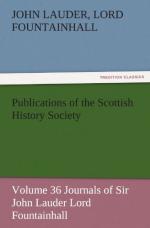On Sunday we went to Coldinghame Kirk, 4 miles from the smith’s house at Haychester. The kirk hes bein a great fabrick. Its said to have bein built by K. Edgar, anno 1098. Their was their a great abbacy. We saw the promontory so much taken notice of by the seamen called St. Abbes head (Sta. Ebba); over forgt[594] it layes Coldinghame Law, Home to his name. Saw the milne about which my Lord Home (who is the Lo. of erection now) and Renton are contending. Saw at 2 miles distance Haymouth,[595] and above it Gunsgrein, then Ayton, all standing on the water of Ei. Saw West Reston, Home, Eist Reston, Craw, and Henchcheid, Craw; of which name their was a nest in this place, but the Earle of Dumbar almost extinguished them, and now his owne memory is extinct and gone: let men then beware of oppression. Coldinghame stands pleasant, and verifies the byword that the kirkmen choised ever the warmest nests. Mr. Andro Ballantyne, brother to the sometyme Lo. Newhall, is heir minister. Auldcambus is in Cockburnspath parish. It hes a ruinous chappell standing in it dedicat to Ste. Helene, who was mother to Constantine the great, and found out the holy croce at Golgotha. Thrie mile from Auldcambus stands Monynet, and 3 miles from it againe stands Gammelisheills in Lammermuire. Blaikerston stands likewayes their about, as also Thorniedykes, now Broun, of old French. After some dayes stay at Auldcambus we came to Dumbar. Nixt day out of Dumbar we came to Northbervick by Belhaven, Tinynghame, Auldham, Scougall, Tomtallon, Cassilton. From Northberwick we went to Archerfield (so called because of the excellent links their fit for shooting at Rovers), my Lo. Advocat’s[596] dwelling. Saw by the way Dirleton, with its castle, ruined by the English becaus it held out. Then from that came to Saltcoats, Leidingtone, to their name; then to Lufnes, of old Biccarton; then Waughtons, now Durhame; then to Abirlady toune and place, once Mr. Wm. Scot’s, now Sir Androw Fletcher’s. Theirs a great bay heir. Then saw Gosford, then Cockeny, the Pans, Wester Pans, wheir Jo. Jousie hes his house.
[594] For ‘forgainst,’ ’opposite.
[595] Now Eyemouth.
[596] Sir John Nisbet of Dirleton.
Naper is a french name and runs in it n’a pair, he hath not a peer. The Giffards of Shirefhall, they say, ware of old Shirefs of Louthian, and from that their house got its denomination. Tho some alledge their was in old tymes a Lord Giffard, and that it ended with ane heritrix married in the house of Yester: yet my Lord Duke of Lauderdale sayes he hes bein at very much pains to find if it was so, and he could never find any thing to instruct it.
* * * * *




